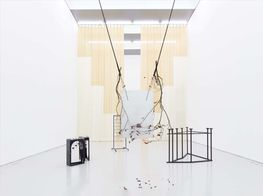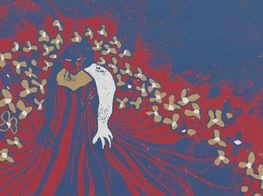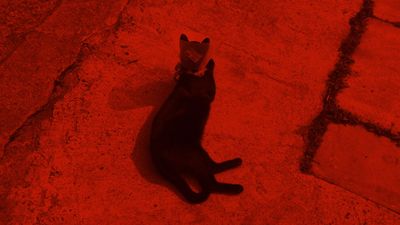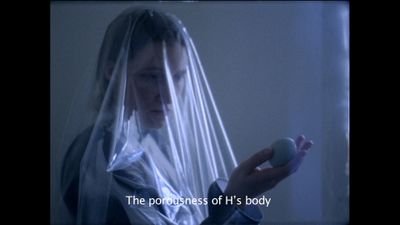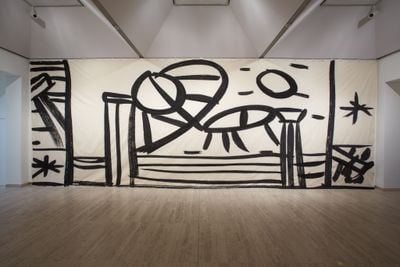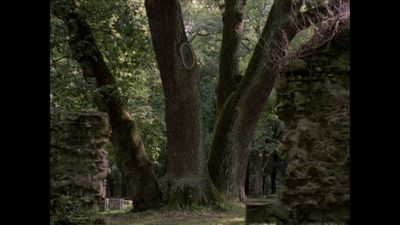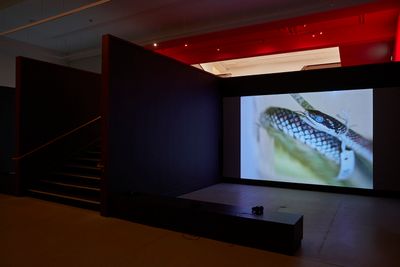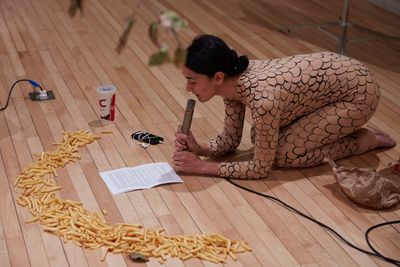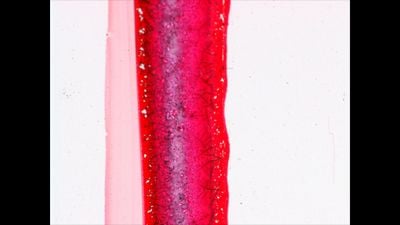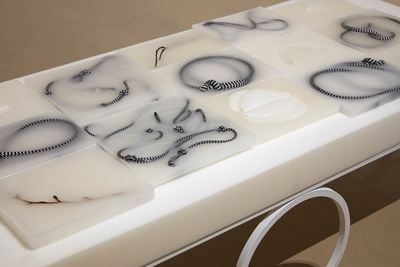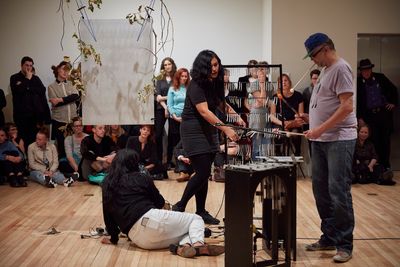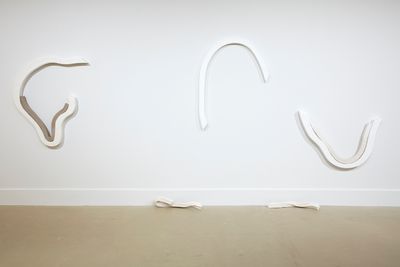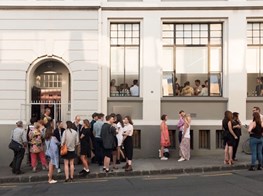Sriwhana Spong
Sriwhana Spong. Photo: Lina Hermsdorf.

Sriwhana Spong. Photo: Lina Hermsdorf.
Sriwhana Spong's first solo museum exhibition in New Zealand at the Govett-Brewster Art Gallery, a hook but no fish (12 May–22 July 2018), explored a unique language—the Lingua Ignota (Latin for 'unknown language')—used by a medieval female German mystic, abbess, composer, and writer Hildegard von Bingen. After its first showing in early 2018 at London's Pump House Gallery in Battersea Park, Spong added new work to her New Zealand show as part of the two months she spent as Govett-Brewster's 2018 Aotearoa New Zealand Artist in Residence.
The exhibition in New Zealand included a hook but no fish (2017), a film that was partially shot at the ruins of a monastery near Frankfurt where von Bingen lived for almost 40 years. Also included was a musical bell plate influenced by Balinese Gamelan, which is part of a series of instruments that Spong has created in response to encounters with certain places and collaborators. Titled Instrument C (Claire) (2018), the bell plate is dedicated to Claire Duncan, who worked on the sound for a hook but no fish. At the Govett-Brewster Art Gallery, attendants were invited to play the instrument according to a score derived from Cum Vox Sanguinis, a hymn by von Bingen. Spong also presented Tasseography of a Rat's Nest (extended) (2018): a performance first created in 2015 during a DAAD residency in Berlin, through which the artist observed the construction of a rat's nest on her window ledge and, tuning into her physical response to it, explored the role of language in how we experience our fears.
In this conversation, Spong speaks to the curator of her New Zealand show, Tendai John Mutambu, about working across film, painting, performance, and sculpture to consider the relationship between the body, language, and sound, as inspired by the practices of medieval women mystics.
TMA conversation has unfolded over the last few years between the work of women mystics and your own. Considering this, I want to begin by situating the origins and the development of this interest by asking how medieval women mystics have informed your practice as an artist and writer?
SSWhile doing my master's at the Piet Zwart Institute in Rotterdam in 2014, I was introduced to the Brazilian writer Clarice Lispector. Her writing came as a shock to me; I hadn't encountered a voice like hers before, and yet it felt familiar. One of my tutors at the time asked what genre Clarice's writing might fall under and I replied, instinctively, 'mystic writing'. This led to an ongoing exploration of medieval mystic texts written by women and their relationship to more contemporary writers—the French feminist thinker Hélène Cixous being a clear example. Through my work, I've been exploring this web of voices and the kind of body proposed by their texts.
TMIn the past you've used the term 'constellation' to connect the women and practices that inform your own. It's as if you are building a 'personal pantheon' of women writers and creators across time—Hildegard von Bingen, who is central to your latest exhibition's titular film, being one such character. Can you tell us a bit about how you see her relating to this 'personal pantheon'?
SSIn 2016, while on residency at Gasworks in London, I made a film about the Christian mystic Margery Kempe (c. 1373–c. 1440), who is believed to have written the first autobiography in the English language. I spent some time researching at the Warburg Institute Library in London, which consists of four levels each dedicated to a different area of study. I was working in the 'Orientation' section, dedicated to Western thought's transition from mysticism and magical belief to religion, science, and philosophy. This categorisation of 'Orientation' led me to think of mystic writers—like Margery and Hildegard—as cartographers mapping out a territory or path; Lispector does a similar thing.
In terms of a 'constellation' of voices or cartographers that influence my work, Hildegard provides a good example of a practice that extends across several mediums and areas of interest. While Hildegard is perhaps best known for her music, she also had visions that she described, interpreted, and illustrated, and she dictated books on the human body, the properties of plants and animals, and their medicinal uses. Today you might call her a multidisciplinary artist.
I encountered Hildegard through an illustration of one of her visions that depicts her scheme of the universe and looks like a fiery cosmic egg and also a lot like a vagina. Hildegard's Lingua Ignota, or Unknown Language is a secret language comprising a glossary of around 1,000 nouns that she claimed to have 'received' by divine inspiration. In this glossary she includes a word for the vulva, fragizlanz, so it doesn't seem too great a stretch to suggest that she had this in mind alongside the grand cosmic scheme of the universe when she directed the drawing of this vision. For me, one of the advantages of being an artist when looking at material like this is that you can be much more playful with your connections than a historian.
TMWhat, for you, is the significance of Hildegard's unknown language and in what ways does it resonate with your thinking around your own place in art, language, and theoretical discourse?
SSHildegard's Lingua Ignota survives as a glossary of nouns that she inserted into Latin, the latter providing verbs, adjectives, and grammatical structure. What drew me to the Lingua Ignota is that it renames the things around Hildegard—things that were part of her daily experience. It gives us a really intimate view of her environment and what she saw and chose to focus on. Hildegard was therefore inserting her perspective into the official, high language of the period—the language of liturgical ceremony and of science, law, and administration, which women were excluded from. I see Hildegard's Lingua Ignota as both a subversive and celebratory gesture where the excluded body inserts itself into the very space it is denied entry, and in doing so creates a new form. At the time, women's bodies were perceived as being grotesque and porous—the opposite of the complete, classically sealed male body. Through the Lingua Ignota, the grotesque enters and erodes the fixed classical form. It makes for a wonderful image, and it's a strategy that I am thinking through in relation to my own work.
I consider 'art history' as largely the history of male looking—and predominantly white male looking. I remember when it dawned on me that I was having to make, think, and act within a structure that was not made for me, or by me. In 2012, I made The Stranger's House, a large theatrical backdrop on which was painted Sidney Nolan's failed design for the original Ballets Russes production of Icare. The work was for a show in a national gallery that has an incredible collection of contemporary art, predominantly by men. Walking around the galleries was like being in a stranger's house, and I became concerned with how to make work in and for this space. This led to the idea of breaking and entering the practice of a much-lauded male modernist painter and stealing a work, only to remake it into something of my own.
While doing my master's, I designed a set of capes for the graduating year ahead of me. I got real enjoyment from designing these costumes—each one was designed especially with the wearer and their practice in mind. I didn't view them as part of my practice, but something extraneous. However, my tutor brought them up during our next studio visit, describing the costumes as actively generating an energy during the graduation ceremony and challenging the seriousness with which I approached what I saw as 'my practice' in the studio. He then posed a series of questions that have since stayed with me, namely: 'What are the value judgements you bring when deciding what is and is not art?' and, 'Who authorises your art-making?'
TMWhere have your attempts to answer the question of authorisation taken you since?
SSI'm interested in the emphasis on experiential knowledge by medieval women mystic writers, which came out of their exclusion from official institutions of learning. This favouring of experiential knowledge causes the body and all its variances to emerge and erupt into their texts, aided by the linguistic techniques that philosopher Michel de Certeau articulates in The Mystic Fable (1982) as composing the mystic style. These texts incorporate different forms, moving from fiction and autobiography to ideas formed through close observation, and they are often filled with oxymorons and vertiginous swings from elation to doubt. In thinking about these texts and their relationship to more contemporary writers such as Clarice Lispector, I'm considering how 'discipline' and 'the disciplinary' relate to my own practice. My interest is in how the undisciplined body does the work of undisciplining the discipline; namely, how the excluded body—previously seen as unruly and in need of containment—can undiscipline writing and other mediums by breaking into these texts and discursive spaces.
I'm also drawn to what medieval scholar Caroline Bynum speaks of as a continuity that is expressed through women's stories from the medieval period as opposed to the upheavals of social drama that men's accounts from the same period contain. So, I've been thinking about this idea of continuity in relation to a chorus of women's voices that writes itself and extends across time.
TMIn your latest film, a hook but no fish, you move quite dexterously from documentation of a site visit on 16mm film to iPhone footage, and from fiction to (auto)biography. The film itself is set across time and place: from the monastery ruins to a living room, a farmhouse, and scenes of birds in Rotterdam and London. In what ways is the medium of moving image conducive to your way of researching, thinking, and presenting ideas?
SSMy method, often rather frustratingly, has been to wait until I chime with something. I then pursue this curiosity through a period of research, and during this time I begin to think through images and montages—juxtaposing things that might not normally meet. Writing has also become important, both as a process and as a material in my films. a hook but no fish is the second time I have incorporated a text I wrote, and its structure reflects the way my writing slips between styles, often weaving together fiction, autobiography, and biography. This weaving of fiction and autobiography stems from my experience of growing up in New Zealand estranged from my Indonesian heritage. Growing up, I felt that this part of me had to be fictionalised and imagined in order to exist, to take up space, to speak.
TMIn what ways do the formal qualities and the structure of the accompanying film having-seen-snake (2016) reflect your inspiration for making this work?
SSWhile on residency in Pittsburgh, I visited a cemetery, and while looking at some of the tombstones I went into a state of enhanced sensory awareness. My body went very still and colour and sound became heightened. After what felt like a long time, I looked down to see a garter snake directly in front of me. It was then that language entered the scene and only then, once the distinction was made between 'me' and 'snake', did I panic. I became interested in this strange and unverifiable moment where I had responded instinctively as just one creature (me) to another (snake), and the distinctions that emerged with the re-entry of language and the fear that these distinctions generated.
As part of the exhibitions at the Pump House Gallery and Govett-Brewster, I gave a performance of Tasseography of a Rat's Nest (extended) (2018)—a work about an encounter with a rat during a DAAD residency in Berlin between 2015 and 2016. The day I moved into my apartment, I noticed a rat on the window ledge, and I began to observe it over time. My initial response was to push it off the window ledge—an action I avoided by asking: 'What makes me fear you?' I then became interested in how you can look at something like a rat ambivalently, neither ennobling nor degrading it. Prior to my encounter with the snake, I had already been thinking about the role of language in how we experience things we fear.
With having-seen-snake, the day after my encounter with the garter snake, I read an interview with the American writer George Saunders in which he perfectly summed up my experience in the cemetery. He called it 'having-seen-snake energy', and this gave me a key towards representing this almost inexpressible experience. I was put in contact with José Padial, a herpetologist at the Carnegie Museum of Natural History. José goes to the Amazon twice a year in search of unknown species of amphibians and reptiles. When I met him, he showed me a snake in a jar that he had just 'discovered' and was in the process of naming. I was drawn to this creature and its designation as nameless—as José says in the interview that is part of the film, if something does not have a name, it does not exist in the scientific community. The action of naming is one way this earlier film connects to a hook but no fish, which was shown alongside having-seen-snake at the Govett-Brewster, and Hildegard's glossary of a thousand nouns which she used to rename the things around her and, in so doing, allowed her to see those things anew.
having-seen-snake is formed through the juxtaposition of two sections: the first is poetic, experiential, affective—it also evokes my experience with the garter snake through painted 16mm film, used deliberately as a reference to the form of the snake through the material's serpentine movement. The film then cuts to a more traditional documentary mode, comprising shots of specimens from the Carnegie Museum of Natural History and audio of my interview with José.
TMhaving-seen-snake concludes with the sound of the Rothschild's mynah, a bird common to Bali, which is nearing extinction. This particular species has figured in your work before and appears in your most recent exhibition in the form of large-scale watercolour paintings. Was it pure coincidence that you happened upon the bird during your residency in Pittsburgh?
SSThe National Aviary in Pittsburgh has a breeding programme for the Rothschild's mynah, or Bali mynah. The bird is endangered due to poaching, and breeding programmes have been set up around the world to try and ensure its survival. I was interested in this creature that could only survive in exile, and so I decided to end the film—about a snake being pulled into existence through the act of naming—with the song of a bird on the brink of extinction.
The idea of conjuring informs the series of sigil drawings in the exhibition. A sigil is an abstract symbol said to have magical powers that represents something you desire to happen and is constructed by combining the letters that make up the thing wished for. In its modern usage, once the final design is reached, you charge the sigil using a private method such as burning it, and the thing you desire will come into being. It's not a practice I engage in personally, but I am interested in the relationship between the terms 'to cast a spell' and 'to spell'—and how both conjure and bring into being the thing named. With this ongoing series, the idea is that a final sigil design is never reached, giving the work an inchoateness that impedes the final moment of fulfilment.
TM__Design For a Horse Bit #2 (2018) has similar origins as a symbol that you have transformed into a design. It also exists as part of the series 'Design For a Horse Bit' (2017–ongoing). What are its origins?
SSThe design for the gate originates from a medieval manuscript of horse bits. I was attracted to their beauty but also their violence. A bit is a kind of tack that is placed in a horse's mouth and used by a rider to communicate with the animal; it's a device used to control and discipline. I settled on translating these bits into gates because, very simply, a gate is used to control access. For the Govett-Brewster exhibition, this gate was used to cut off audience access to the sigil paintings.
TMYou've recently made a piece of furniture as an addition to a series of works that bear the initials of people in your life, 'MF!VS!TB!' (2015)—members of the personal pantheon we mentioned earlier: women mystics, artists, peers. Could you talk us through the thinking behind this body of work?
SSOne of my favourite works is Portrait of Marcel Duchamp and Rrose Sélavy (1923) by the American artist and poet Florine Stettheimer. It is a portrait of Marcel Duchamp and his female alter ego Rrose Sélavy, and around the frame's edge are his initials, 'MD', repeated. The first in my series of furniture-type sculptures was a set of tables made using the initials of peers, with the idea being that after the exhibition, the sculptures would be given to their namesake to become surfaces on which they could make new work.
__
Scaurin Ranzgia (night tongue) (2018) is an homage to Hildegard that is both a bed and a portrait. Hildegard was known to suffer bouts of illness during which she had visions. Her book Scivias describes 26 of these visions. I'm interested in contemporary readings of Hildegard's visions as pathological, which is reflective of a tendency in art history to pathologise and read the creative output of women through the lens of biography. Placed on the bed are 14 wax tablets from which embedded horse harnesses emerge like snaking, half-formed letters—a body being written from a material used for bridling, reflective of the style of writing produced by the women mystics that exceeded the structures that served to discipline and silence them.
TMCould you also talk us through the instruments you have presented in these exhibitions?
SSThe instruments are part of an ever-expanding personal orchestra inspired by the percussive instruments of Balinese Gamelan. Traditionally, each village in Bali has its own tuning system, so you cannot take an instrument from one village and play it in another, as the pitch is unique to each community.
I see my instruments as records of the places I make work in and the people I collaborate with. Each instrument is named after someone. Instrument C (Claire) (2018) is named after Claire Duncan, who worked on the sound for the film a hook but no fish. Instrument B (Vivian) (2016) is a keyed metallophone named after Singaporean musician Vivian Wang, who set the scale and first played the instrument. Instrument D (Vera) (2018) is named after my friend Vera Mey, and consists of a set of chimes made from aluminium-cast French fries. This last work draws on the use of common food items, like fries, by my family in Bali as daily offerings through which everyday substances are transformed into a site of communion and a medium of contact with the sacred.
These instruments are only ever played by invited performers on specific occasions. The bell plate, Instrument C (Claire), was played by museum attendants according to a score made by forcing two structures onto one another. The score is a notation of Cum Vox Sanguinis, a hymn by Hildegard, onto which the museum's opening hours were placed to determine when and how the bell plate was struck.
The Pump House Gallery, for which Instrument C (Claire) was made, is in Battersea Park, which includes a tropical garden of plants from the colonies. For my show in London, I placed foliage from this garden against a bell plate tuned to E2, which distorts the sound whenever it is played, adding rustles and scratches to its sound. Because I could not import these leaves into New Zealand, I reversed the process at the Govett-Brewster Art Gallery and used foliage from non-indigenous trees from a local park.
TMThere is an accompanying trio of dresses, two of which relate to your interest in synaesthesia. The third and latest one is a silk dress dyed in Coca-Cola and patterned with vegetable oil. What is the thinking behind these costumes?
SSHz Dress B and Hz Dress C were made to accompany Instrument B (Vivian) and Instrument C (Claire), respectively. Both costumes were designed by matching the frequency of the notes chosen for each instrument to a colour that is consonant with that note, using a method developed by the American ethnomusicologist Clint Goss. I'm drawn to these speculative and pseudo-scientific attempts at creating maps and charts based on the experience of synaesthesia: a phenomenon whereby the stimulation of one sensory pathway leads to automatic, involuntary experiences in another. The question, as with my experience in Pittsburgh with the snake or Hildegard's visions, is this: how does one represent such vivid yet unverifiable experiences?
Costume for Instrument D (Vera) uses a common drink to create an intimacy between the audience and the work through recognition and memory—in particular the embodied memory of tasting and drinking as a form of communion. As part of Oceanic Feeling with Maria Taniguchi at LASALLE College of the Arts, ICA Singapore, I presented Villa America (2012), a large silk banner dyed in Fanta to create a vibrant shade of orange, and my show at Michael Lett in 2017 included a similar work dyed with grape Fanta and Coke. These works were inspired by American musician and writer Ian F. Svenonius's essay 'The Bloody Latte: Vampirism as Mass Movement'—a text that tells the history of beverages and their movement as acts of colonial bloodsucking. But the dyed silk banners and dresses function as more than an unalloyed reproach of global homogeneity, colonisation, and capitalism. They consider the power of collective experience, acknowledging these consumed substances' effects as being at once toxic and joyous.
TMOn the subject of shifting between toxic and the joyous, you perform, in your most recent exhibition a kind of feminist détournement by repurposing a scathing review of your work to create a new poetic text.
SSIn Bad Review (2018), I take a review written in response to my recent work and respond, in turn, by cutting it up and collaging it back together to create a new body of writing. This gesture echoes the way Hildegard's Lingua Ignota was inserted into Latin phrases—cutting into the 'high language' of her time and infecting it with her own glossary. Through this action, Hildegard's private language enacted a disruption of institutional language, which inspired my own reconstitution of a formal art review into my own writing. Collage gives a material quality to the texts, while the iridescent red light, although intangible, suffuses the room and permeates the viewer's psychic space, repeating the use of cinematic gels in both films, having-seen-snake and a hook but no fish.
TMAnd, finally, with Oirclamisil (ear cartilage) #1–4 (2017–2018), what aspects of the work's material transformation interests you most?
SSThe title Oirclamisil is derived from Hildegard's word for ear cartilage. A support structure based on the curvatures of the ear was made using paraffin wax. Resting on these ledges are lengths of clay, left to air dry during install and the first few weeks of the show, depending on the temperature and humidity levels in the gallery. As the clay dries it shrinks, pulling away from the support structure at various points, at once conforming and resisting, echoing the way language shapes and writes us as subjects who work with and against it to find our own ways of speaking.—[O]

